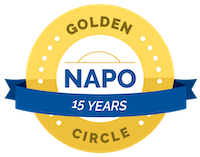Mark Forster helps me keep my sanity
I’ve been a follower of time-management expert Mark Forster for years now. When he develops a new time-management system, I sit up and take notice.
And I usually try it out. And I usually tell you about it. Mark’s task-management innovation, Autofocus, has gone through a number of iterations. I’d tried out the various versions of it, but in recent months strayed from Autofocus in favor of personal kanban, which I also blogged about.
Personal kanban was working for me, until I got crazy busy. In the last 30 days or so, my task list has been very long, due to a busy client load plus my duties as marketing director of the National Study Group on Chronic Disorganization, which is in the process of changing its name to the Institute for Challenging Disorganizaton. With my task list so long, I didn’t have room on my personal kanban whiteboard and it stopped being effective.
For a couple of weeks I floundered with regular old to-do lists. Then I tuned back into Mark Forster and discovered, via the Lifehacker blog, that Mark had tweaked Autofocus once again. And I really like this newest version.
It’s simple: Start with a ruled notebook. Mark three successive pages with the following headers: New, Recurring, Unfinished. Then do a brain dump onto the New page with 10 to 20 tasks that you need to do. Draw a line under them. These become your Old tasks. Any New tasks you think of after that go under the line.
Read through the Old tasks, and do any that appeal to you. If you finish the task, cross it off. If you don’t, add it to the Unfinished page. If it’s a Recurring task (like “scoop the litterbox”), add it to the Recurring page. Keep circulating through the Old tasks (ignoring the others) until no more stand out to you to be done. The move on to the New tasks. When you’ve done all those in the New list that appeal to you at the moment, move on to Recurring and Unfinished. Then go back to Old.
The one big rule that is if you read through the Old list (that is, those tasks above the line) and don’t do any of those tasks, you must dismiss them all. That’s right, highlight them and just accept that you’re not going to do them. Later you can add them to the new list if you want to. The effect of this dismissal rule is that you get your old stuff done, rather than letting them languish on a list. Or you don’t, but you stop nagging yourself about those tasks and just accept that you’re not going to do them.
Once all the Old tasks are crossed off or dismissed, draw a line underneath the last New task. The tasks between the lines now become the Old tasks. Simple. Elegant. Beautiful.
I’ve been using this system for just a few days now, but I’m loving it. Separating out the Recurring and Unfinished tasks really helps me make sure the older stuff doesn’t get lost in the shuffle. It keeps my list shorter, since I’m not constantly crossing out and re-adding recurring tasks. And, as in other Autofocus system, it gives my brain a break because I have an easy place to write everything down and I don’t have to worry about remembering tasks. I don’t have to categorize or prioritize. I just add new tasks to the end of the list.
This is a clean and simple version of the method that’s not only easy to try but very effective. I think this new Autofocus is going to allow me to get through December with my sanity intact!
Tagged with: autofocus, mark forster, task list, task management, time management, to-do list
Comments
Links
- Shannon Wilkinson, life coach
- Ravelry
- NAPO St. Louis
- Institute for Challenging Disorganization
- Getting to Good Enough podcast
- Peace of Mind Budgeting
- Organize Your Family History
- Are you interested in becoming a professional organizer?
- National Association of Productivity and Organizing Professionals







